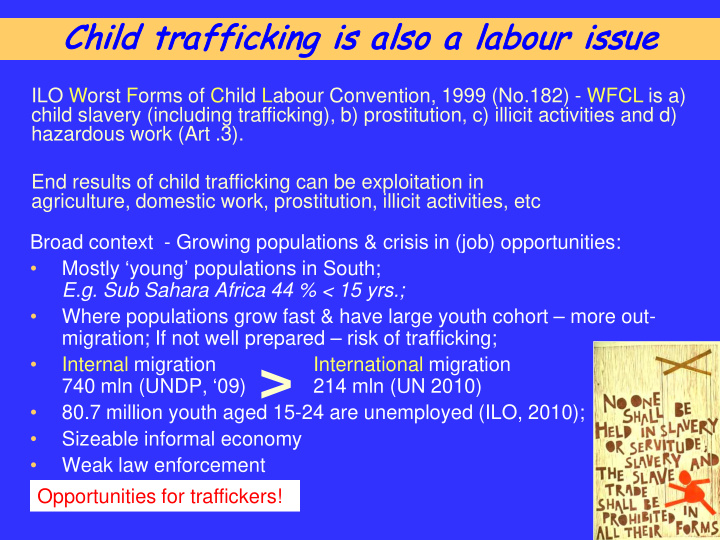



Chil ild tr d traffic fficking is ing is also a labour ur is issue ue ILO Worst Forms of Child Labour Convention, 1999 (No.182) - WFCL is a) child slavery (including trafficking), b) prostitution, c) illicit activities and d) hazardous work (Art .3). End results of child trafficking can be exploitation in agriculture, domestic work, prostitution, illicit activities, etc Broad context - Growing populations & crisis in (job) opportunities: • Mostly ‘young’ populations in South; E.g. Sub Sahara Africa 44 % < 15 yrs.; • Where populations grow fast & have large youth cohort – more out- migration; If not well prepared – risk of trafficking; > • Internal migration International migration 740 mln (UNDP, ‘09) 214 mln (UN 2010) • 80.7 million youth aged 15-24 are unemployed (ILO, 2010); • Sizeable informal economy • Weak law enforcement Opportunities for traffickers!
Global estim timate te of f size ize of f pr problem ILO, 2005: 2.45 million persons in forced labour as a result of trafficking (‘stock’, not ‘flow’; Capture – recapture method); 40 to 50% is children under 18; Progr gress in m in measur urement nt te techniq nique ues fo for natio na tiona nal e estim timate tes • Better - sampling techniques - design of questionnaire - indicators of exploitation and coercion; Ways forward for national estimation: • HH-based surveys at source to capture returnees; • HH-based surveys at destination to capture victims; • Establishment based surveys where possible; • Triangulation + avoid double counting. Political will crucial
Ris isk fa facto tors & & vul vulne nerabil ility ity a at m t many ny leve vels 1. External & institutional risk factors Macro level Distant Intermediaries Clients relative Recruiters Employers 4. Community risks at source 5. Workplace risks 3. Family risk at destination factors Vulnerable child Micro At Source At Destination level 2.Individual risk factors In Transit
Law enforcement against traffickers is crucial. Other options include: Safe fe(r (r) m ) migr igratio tion… n… Policies and services at source (prior to departure) • To postpone migration: education and youth employment; • Access to cheap credit; • Pre-departure orientation, including life skills training; • Licensed and monitored recruitment agencies; • Hold recruitment agencies liable for exploitation if employer cannot be charged. Policies and services (in transit) • Trained police and workers in the transport sector monitor trafficking; • Information services on trains/busses/ferries & at stations; • Link between sending & receiving area; • Functioning hotline services - trained staff & referral services.
…f …for d r dece cent w work* rk* Policies and services at destination (and in workplace) • Apply minimum employment age; • Extend the reach of labour law & regulate the informal economy; • Improved labour inspection; • Complaints & settlement mechanisms; • Punish exploiters & hurt them in pocket; • Drop-in centers that offer information, counseling, legal assistance, NFE. Also engage actors beyond government: • Address public indifference to exploitation; • Youth empowerment and self protection; • Engage the business community; • Youth able to join or associate with trade unions; • Universities! * for youth of working age (i.e. 15) For more please contact: Hans van de Glind at vandeglind@ilo.org or visit: http://www.ilo.org/ipec/areas/Traffickingofchildren/lang--en/index.htm
Recommend
More recommend